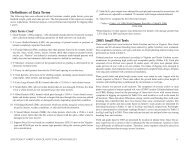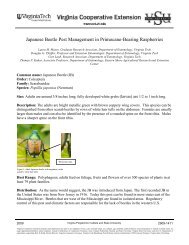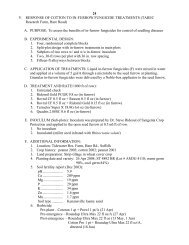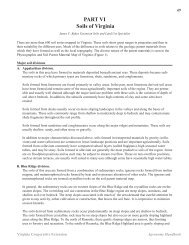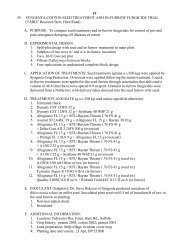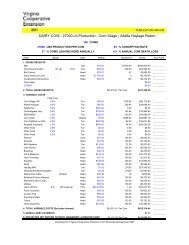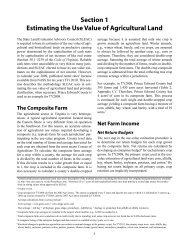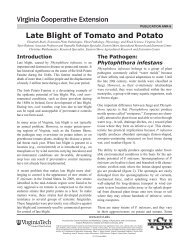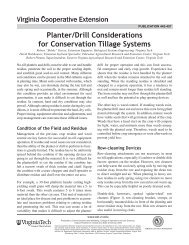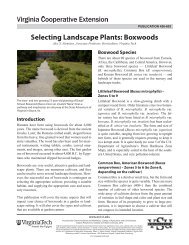PDF (1 MB) - Virginia Cooperative Extension - Virginia Tech
PDF (1 MB) - Virginia Cooperative Extension - Virginia Tech
PDF (1 MB) - Virginia Cooperative Extension - Virginia Tech
You also want an ePaper? Increase the reach of your titles
YUMPU automatically turns print PDFs into web optimized ePapers that Google loves.
Three possible sources of primary inoculum were evaluated at each site: 1) native plant<br />
species that might potentially harbor Gray Mold mycelium or spores; 2) soil, a possible<br />
overwintering site for the sclerotial form; and, 3) transplants that may be capable of<br />
introducing latent infections into the field. On studying this paper, I was relieved to note they<br />
found no indication of Gray Mold on soils or on native plant material. However, when they<br />
incubated strawberry foliage from the newly set plots at time of transplanting, bingo! The<br />
percentage of latent infection being brought into the field ranged from 12 to 66% of all leaves<br />
sampled, plugs or bare roots made no difference. Thereafter, newly emerging leaves sampled<br />
monthly across the fall and early winter showed a very high percentage of infected leaves.<br />
So now we know, we were loaded with Gray Mold infection long before bloom or fruit<br />
development in the spring! I expect our dormant-dug Eastern U.S. bare root plants would<br />
show similar results, since Gray Mold is found everywhere there are strawberries.<br />
A very sustainable idea generated by this paper is that we CAN greatly reduce Gray Mold<br />
infection by removing all dead leaves and runner growth in late winter and early spring. Get<br />
the dead growth of old runners and old leaves off the plastic mulch even on new plantings<br />
where dead leaf growth is present (hopefully, fewer runners on new plantings).<br />
Next on the Gray Mold control agenda, after dead leaves and runners removal, is to apply a<br />
thorough, tank-mix fungicide spray to the plants just as the new spring foliage growth flush<br />
occurs, coming usually by early March to warmer, lower elevation areas, usually about early<br />
April here. Don’t wait until first bloom to begin, but complete perhaps 4 such combination<br />
tank-mix sprays before first fruit ripens. Waiting until you see Gray Mold developing on<br />
ripening fruit to apply later sprays during harvest season is a waste of money and your time!<br />
Combination tank-mix fungicides alternated as per our VCE Pub. 456-420 reduce single<br />
fungicide-resistant fungus “escapes.” Check your annually updated <strong>Cooperative</strong> <strong>Extension</strong><br />
fungicide recommendations as per VCE Pub. 456-420.<br />
A big advantage to consumers by this approach is that we don’t load ripening fruit and foliage<br />
with visible fungicides. Late winter plant cleaning plus four well-timed and early sprays, one<br />
at first growth flush after cleaning off dead plant growth from the raised, plastic-mulched beds,<br />
a second at first to 10% bloom, a third at full bloom, and a fourth at late or extended bloom,<br />
will, together with removal of dead plant material from the beds, reduce your former Gray<br />
Mold management program costs by 50% to 75% (from 6 to 8 wrongly timed sprays down to<br />
4 properly timed sprays), provide much less Gray Mold, and provide clean fruit and harvesting<br />
environment with no spray residues! Good, strawberry-committed <strong>Virginia</strong> growers proved it<br />
again in our very wet bloom/harvest 1998 year! In visits to grower fields, we’ve noted great<br />
variation concerning grower successes and failures to control Gray Mold this spring. The<br />
consistent pattern was that where growers applied (and reapplied in wet weather) pre-bloom<br />
and bloom fungicide sprays, Gray Mold was effectively controlled. We CAN whip it!<br />
31





